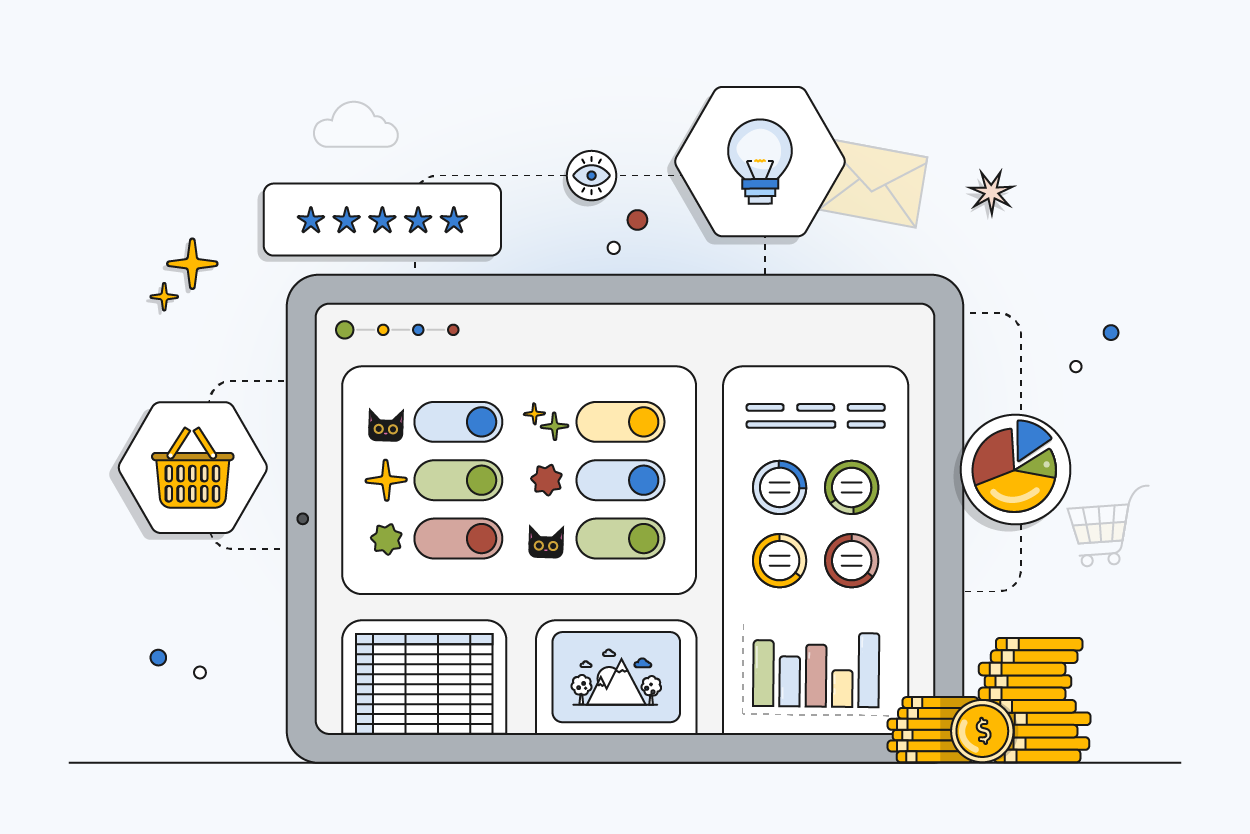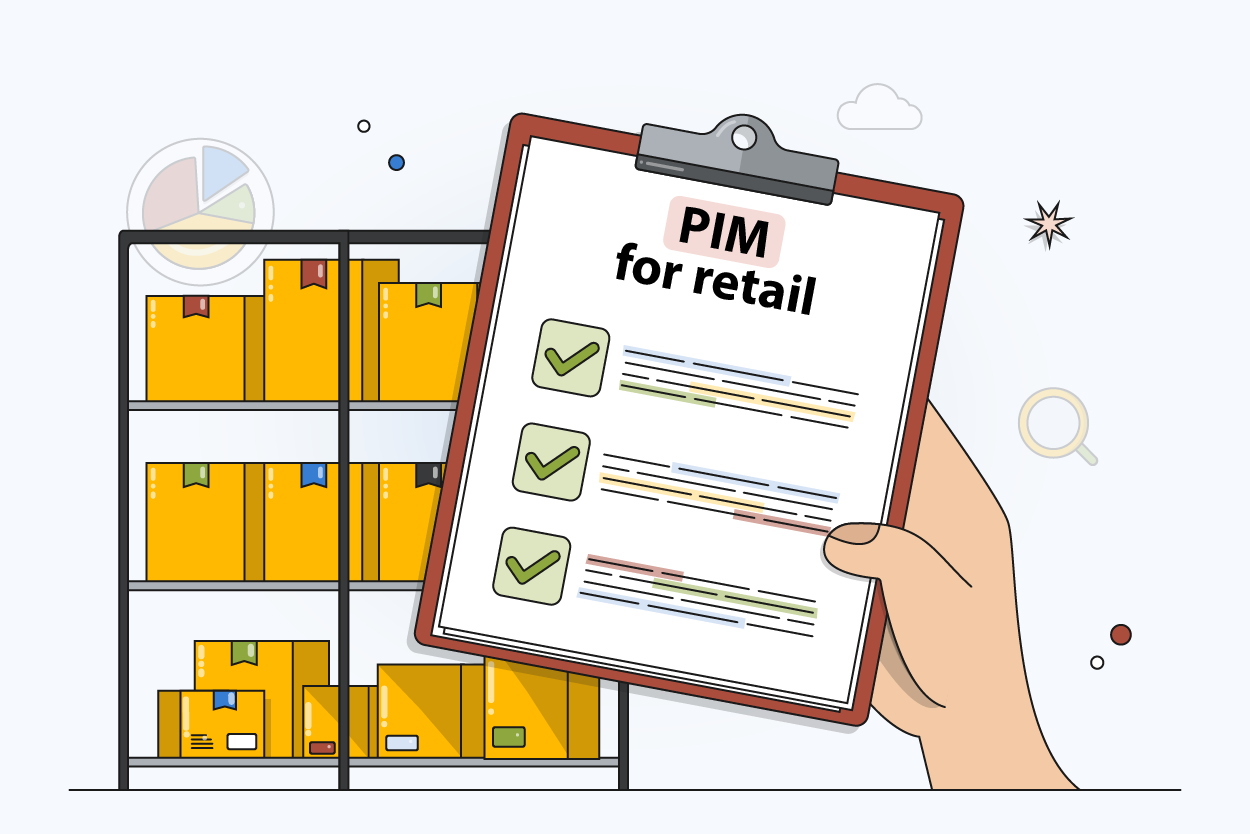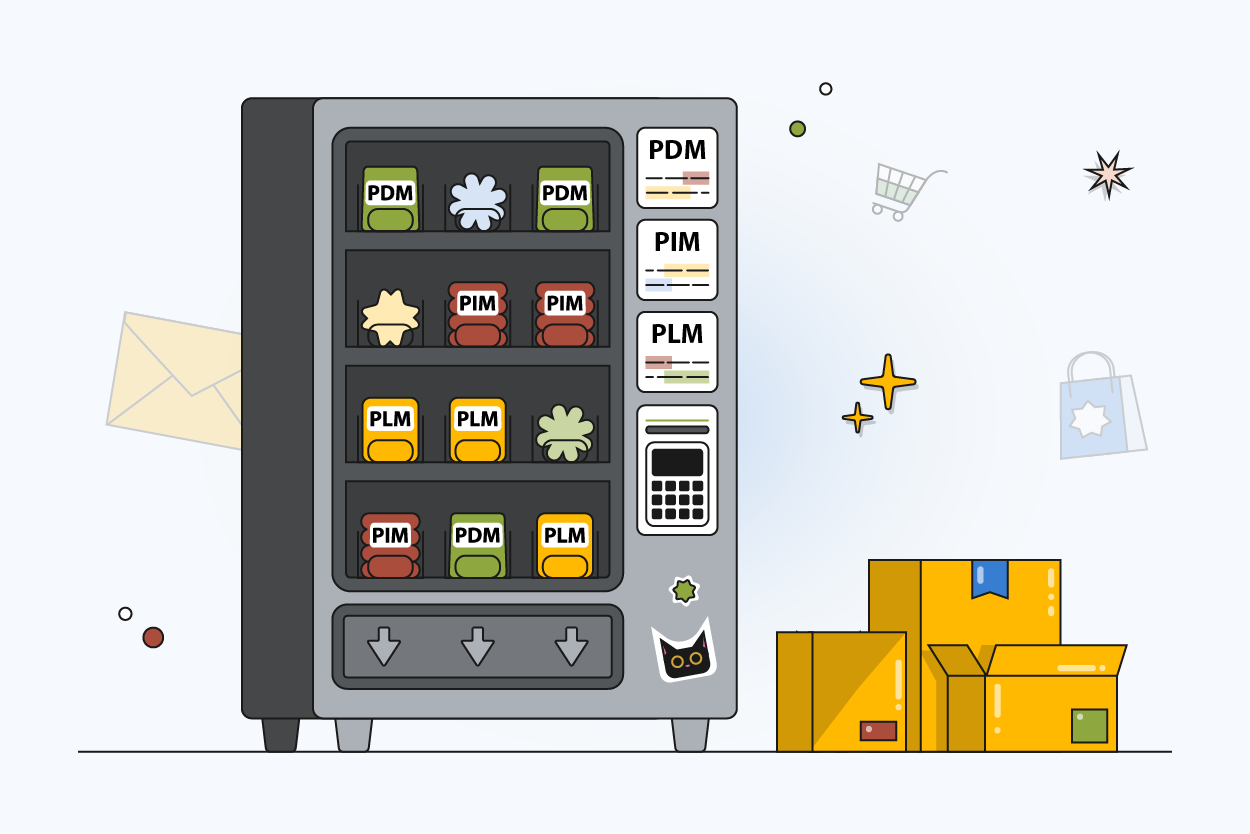Product Information Management (PIM) System: A Comprehensive Guide
Author name: Mark Chickering

What is a Product Information Management (PIM) System?
A Product Information Management (PIM) system is a business application designed to manage all the product information and attributes required to market and sell products through various distribution channels. It serves as a central platform to collect, maintain, and enrich information and content related to products and distribute it to marketing, sales, and eCommerce channels.
A PIM system is crucial in today's digital age, where businesses must manage vast amounts of product data and ensure that accurate, up-to-date information is available across all platforms. It helps improve operational efficiencies, enhance product data quality, and deliver a superior customer experience.
Comparison between PIM and CMS
While both PIM and Content Management Systems (CMS) are used to manage and distribute content, they serve different purposes. A CMS primarily manages digital content, such as website content, blogs, and articles. On the other hand, a PIM system is specifically designed to manage product information.
A PIM system is more suitable for businesses that need to manage complex product data and distribute it across multiple channels. In contrast, a CMS is more appropriate for businesses that primarily need to manage and distribute digital content.
Who Uses PIM Systems?
PIM systems are used by a wide range of businesses, from small startups to large multinational corporations. Industries that commonly use PIM systems include retail, manufacturing, and eCommerce. These systems are particularly beneficial for businesses with large product portfolios, multiple distribution channels, or those operating in multiple markets or countries.
Why Do Businesses Choose PIM Systems?
Understanding the theory is one thing, but what are the real-world benefits? Discover the tangible advantages that make PIM essential for growing businesses.
The Purpose of a PIM System
The primary purpose of a PIM system is to provide a single source of truth for all product information. It helps businesses manage and distribute accurate, consistent product data across all channels (multi-channel distribution,) thereby reducing errors, improving efficiency, and enhancing the customer experience.
A PIM system also facilitates faster product launches, as all the necessary product information can be quickly and easily accessed from one place. Moreover, it helps businesses comply with various industry and regulatory standards by ensuring that all product information is accurate and up-to-date.

Multi-Channel Distribution with a Product Information Management (PIM) System
In today's digital age, businesses often sell their products across multiple channels, including their own eCommerce website, online marketplaces like Amazon and eBay, social media platforms, and even offline channels like physical stores or print catalogs. Multiple channels refer to the various platforms or mediums through which a business sells its products or interacts with its customers. Here are some examples of these channels:
- Ecommerce Websites: This is often the primary channel for many businesses. It could be a business's own website where customers can browse and purchase products directly.
- Physical Stores: Brick-and-mortar stores are still a significant channel for many businesses, especially for those selling products that customers prefer to see and try before purchasing.
- Online Marketplaces: Platforms like Amazon, eBay, and Alibaba are popular channels for businesses looking to reach a larger audience. These platforms host products from multiple sellers and handle the transaction process.
- Social Media Platforms: With the advent of social commerce, platforms like Facebook, Instagram, and Pinterest have become important sales channels. Businesses can showcase their products directly on their social media profiles and even enable direct purchases.
- Mobile Apps: Many businesses have their own mobile apps to provide a seamless shopping experience for customers using smartphones or tablets.
- Catalogs: Both digital and print catalogs are used by businesses to showcase their products. These are often used in B2B scenarios, but also in B2C contexts.
- Email Marketing: While not a sales channel per se, email is a significant channel for promoting products to customers and directing them to the point of purchase.
- Third-Party Retailers or Distributors: For many businesses, especially those in the manufacturing sector, third-party retailers or distributors can be a significant sales channel.
Managing product information across all these channels can be a complex task, but a Product Information Management (PIM) system can greatly simplify this process. Here's how:
Centralized Data Distribution
A PIM system serves as a centralized hub for all product data. This includes product descriptions, specifications, images, and other related information. When you update product information in the PIM system, it can automatically distribute these updates to all connected sales channels. This ensures that all channels have access to the same, up-to-date product information, helping to create a consistent customer experience across all touchpoints.
Channel-Specific Requirements
Different sales channels often have different requirements for product information. For example, an online marketplace might require a specific format for product descriptions, while a print catalog might require high-resolution images. A PIM system can store and manage these channel-specific requirements, ensuring that each channel receives product information in the correct format.
Seamless Integration
Many PIM systems can integrate directly with various sales channels, allowing for seamless data flow between systems. For example, if you sell products on Amazon, you can integrate your PIM system with Amazon's API to automatically upload product information and receive updates about orders and inventory levels. This can save time and reduce the risk of errors compared to manual data entry methods.
Scalability
As your business grows and you add more products or sales channels, a PIM system can easily scale to meet your needs. You can add new products or channels to the system without having to worry about managing additional data sources or systems. This can help your business stay agile and responsive as it grows.
A PIM system plays a crucial role in multi-channel distribution, helping businesses manage and distribute product information efficiently and effectively. By ensuring that all sales channels have access to accurate, up-to-date product information, businesses can create a consistent customer experience, improve operational efficiency, and drive sales growth.
How to Implement a PIM System
Implementing a PIM system involves several steps, including:
- Identifying Business Needs: Before selecting a PIM system, businesses need to identify their specific needs and objectives.
- Selecting a PIM System: Based on the identified needs, businesses can select a PIM system that best fits their requirements.
- Data Migration: The next step is to migrate existing product data to the new PIM system.
- Training: It's crucial to train all relevant staff on how to use the new PIM system effectively.
- Integration: The PIM system needs to be integrated with other business systems, such as ERP and eCommerce platforms.
Ready to Choose Your PIM System?
Selecting the right PIM is critical. Before you make a decision, understand the 15 criteria that separate good systems from great ones, and compare the top solutions available in 2025.
Top Product Information Management (PIM) Systems
There are several PIM systems available in the market, each with its unique features and benefits. Some of the top PIM systems include:
- PIMinto PIM: User-friendly interface with fast data serving and ease of integration. PIMinto is popular due to it's scalability, ease of use, pricing and unique direct data serving features.
- Plytix PIM: Known for its user-friendly interface Plytix PIM is a popular choice among businesses of all sizes.
- Sales Layer PIM: This system provides automation capabilities and integration with various eCommerce platforms.
- Akeneo PIM: Akeneo is known for its open-source nature, making it a choice for many businesses.
Today's Benefits of PIM Systems
As businesses continue to expand their digital presence, the demand for PIM systems is expected to grow. Businesses increasingly rely on PIM systems to manage their complex product data and deliver a consistent and personalized customer experience across all channels.
PIMS offer:
- Centralized Data Management: A PIM system serves as a single source of truth for product data, helping align all teams and departments around a shared platform. It collects, enriches, and stores product information in one place, ensuring consistency and accuracy across all channels.
- Efficient Data Handling: PIM systems reduce manual data entry by taking in product related data from other systems, then publishing product information to your eCommerce store and online sales channels. This efficiency can save time and reduce errors.
- Automation and Collaboration: PIM systems provide automation capabilities to speed up workflows and facilitate collaboration and product information sharing across departments, businesses and platforms. This can enhance productivity and ensure that all teams are working with the same, up-to-date product information.
- Improved Customer Experience: By providing accurate, comprehensive, and up-to-date product information, PIM systems can enhance the customer experience. They can help build customer trust, which is the foundation of sales, especially in an eCommerce context.
- Multi-Channel Management: PIM systems can help your business store, upload, and manage your products across multiple sales channels. This is particularly important in today's omnichannel retail environment, where customers expect to see consistent product information across all platforms.
Centralized Data Management with a Product Information Management (PIM) System
In the world of eCommerce and multi-channel retail, managing product information can be a complex task. Businesses often have to deal with large volumes of product data, including descriptions, specifications, images, and more. This data needs to be consistent and up-to-date across all sales channels, which can be a challenge when it's stored in multiple, separate systems. This is where a Product Information Management (PIM) system comes in.
- Single Source of Truth: A PIM system serves as a single source of truth for all product data. It provides a centralized platform where businesses can collect, manage, and distribute all their product information. This means that all teams and departments – from marketing and sales to customer service and logistics – have access to the same, up-to-date product information. This can help prevent inconsistencies and errors that can occur when product data is stored in multiple, separate systems.
- Data Consistency and Accuracy: By storing all product data in one place, a PIM system ensures data consistency and accuracy. Any changes or updates to product information are immediately reflected across all sales channels, ensuring that customers always have access to the most accurate and up-to-date product information. This can help build customer trust and satisfaction, which are key to driving sales and loyalty in the competitive world of eCommerce.
- Streamlined Data Management: A PIM system provides tools and features that streamline the process of managing product data. This can include bulk upload features, which allow businesses to upload large amounts of product data at once, as well as data validation features, which automatically check product data for errors or inconsistencies. These features can save time and reduce the risk of errors compared to manual data entry methods.
- Improved Collaboration: A PIM system can also improve collaboration between teams and departments. By providing a shared platform for managing product information, it ensures that all teams are working with the same data. This can help prevent miscommunication and confusion, and ensure that all teams are aligned around the same product information.
Centralized data management with a PIM system can bring significant benefits to businesses. By providing a single source of truth for product data, it can help ensure data consistency and accuracy, streamline data management processes, and improve collaboration between teams. This can ultimately lead to improved customer satisfaction and increased sales.
Data Enrichment with a Product Information Management (PIM) System
In the world of eCommerce, the quality of your product data can significantly impact your sales and customer satisfaction. Customers today expect detailed, accurate, and engaging product information to make informed purchasing decisions. This is where data enrichment with a Product Information Management (PIM) system comes in.

What is Data Enrichment?
Data enrichment involves enhancing, refining, and improving raw product data to make it more meaningful and valuable. This can include adding additional attributes, categorizing products, optimizing product descriptions for SEO, and more. The goal is to provide customers with comprehensive, engaging, and accurate product information that helps them make informed purchasing decisions.
A PIM system provides a range of tools and features that can help with data enrichment:
- Adding Additional Attributes: A PIM system allows you to add additional attributes to your products, such as color, size, material, or any other characteristic that might be relevant to your customers. These attributes can help customers find exactly what they're looking for and make more informed purchasing decisions.
- Categorizing Products: A PIM system can help you categorize your products in a way that makes sense to your customers. This can make it easier for customers to browse your product range and find the products they're interested in.
- Optimizing Product Descriptions: A PIM system can help you optimize your product descriptions for SEO, making your products more discoverable on search engines. This can include adding relevant keywords, writing engaging product descriptions, and more.
- Adding Images and Videos: A PIM system allows you to add images and videos to your product descriptions, providing a more engaging and informative shopping experience for your customers. High-quality images and videos can help customers understand what they're buying and can significantly impact purchasing decisions.
- Managing Multilingual Content: If you sell your products in multiple countries, a PIM system can help you manage multilingual product content. This ensures that all your customers, regardless of their language, have access to accurate and engaging product information.
Data enrichment with a PIM system can significantly enhance the quality of your product data, leading to a more engaging shopping experience for your customers and potentially increasing sales. By providing comprehensive, accurate, and engaging product information, you can build customer trust and satisfaction, which are key to success in the competitive world of eCommerce.
Integration Capabilities of a Product Information Management (PIM) System
In the modern business landscape, organizations often rely on a variety of systems and platforms to manage different aspects of their operations. These can include Enterprise Resource Planning (ERP) systems, Customer Relationship Management (CRM) systems, eCommerce platforms, and more. The ability to integrate these systems is crucial for ensuring seamless operations and data consistency. This is where the integration capabilities of a Product Information Management (PIM) system come into play.
- Seamless Data Flow: A PIM system serves as a centralized hub for all product data. By integrating the PIM system with other business systems, you can ensure seamless data flow between systems. For example, product data stored in the ERP system can be automatically imported into the PIM system. Similarly, any updates to product information in the PIM system can be automatically reflected in the eCommerce platform. This ensures that all systems are always up-to-date with the latest product information.
- Improved Efficiency: By integrating the PIM system with other business systems, you can significantly improve operational efficiency. Manual data entry can be reduced or eliminated, saving time and reducing the risk of errors. Moreover, by automating data synchronization between systems, you can ensure that product information is always up-to-date across all channels, without the need for manual updates.
- Enhanced Customer Experience: The integration capabilities of a PIM system can also enhance the customer experience. By ensuring that all sales channels have access to the same, up-to-date product information, you can provide a consistent and accurate shopping experience for your customers. This can help build customer trust and satisfaction, which are key to driving sales and loyalty.
- Scalability: As your business grows and your needs evolve, the integration capabilities of a PIM system can help you scale your operations. You can easily add new sales channels or integrate new business systems as needed. This flexibility can help your business stay agile and responsive as it grows.
Future Benefits of PIM Systems
Artificial Intelligence (AI) is set to have a significant impact on Product Information Management Systems (PIMs) in the future. Here's how:
- Automated Data Management: AI can automate many of the routine tasks involved in managing product information. This includes tasks like data entry, data validation, and data synchronization across multiple channels. By automating these tasks, AI can save time, reduce errors, and improve the overall efficiency of product information management.
- Improved Data Quality: AI algorithms can analyze product data to identify errors, inconsistencies, or gaps in the data. They can then either correct these issues automatically or alert users to the issues so they can be addressed. This can help improve the quality of product data and ensure that customers always have access to accurate and up-to-date product information.
- Predictive Analytics: AI can analyze historical product data to predict future trends and patterns. This can help businesses anticipate changes in demand, adjust their product offerings accordingly, and ensure that product information is always relevant and up-to-date.
- Natural Language Processing (NLP): AI can use NLP to understand and generate product descriptions in a way that is both appealing to customers and optimized for search engines. This can help improve product discoverability and attractiveness on various sales channels.
In conclusion, the future integration of AI into PIM systems may bring significant benefits, including improved efficiency, data quality, and customer experience. As AI technology continues to evolve, we can expect to see even more innovative applications of AI in product information management in the future.
Not Sure If You Need a PIM? Take Our Quick Assessment
Answer 8 quick questions to get a personalized recommendation on whether a PIM system is right for your business — and which features you should prioritize.
PIM Systems: Essential Infrastructure for Modern Product Management
In conclusion, the integration capabilities of a PIM system can bring significant benefits to businesses. By ensuring seamless data flow between systems, improving operational efficiency, enhancing the customer experience, and providing scalability, a PIM system can be a valuable tool for managing product information in a multi-channel retail environment.
A Product Information Management (PIM) system is an essential tool for businesses in today's digital age. It not only helps in managing complex product data but also plays a crucial role in improving operational efficiency, enhancing customer experience, and driving business growth. By understanding what a PIM system is, its purpose, and how to implement it, businesses can make an informed decision and select a PIM system that best fits their needs.
Ready to Transform Your Product Data Management?
See how PIMinto can centralize your product information, streamline multi-channel distribution, and accelerate your time-to-market. Book a personalized demo with our team.
Modified on: 2023-09-10



